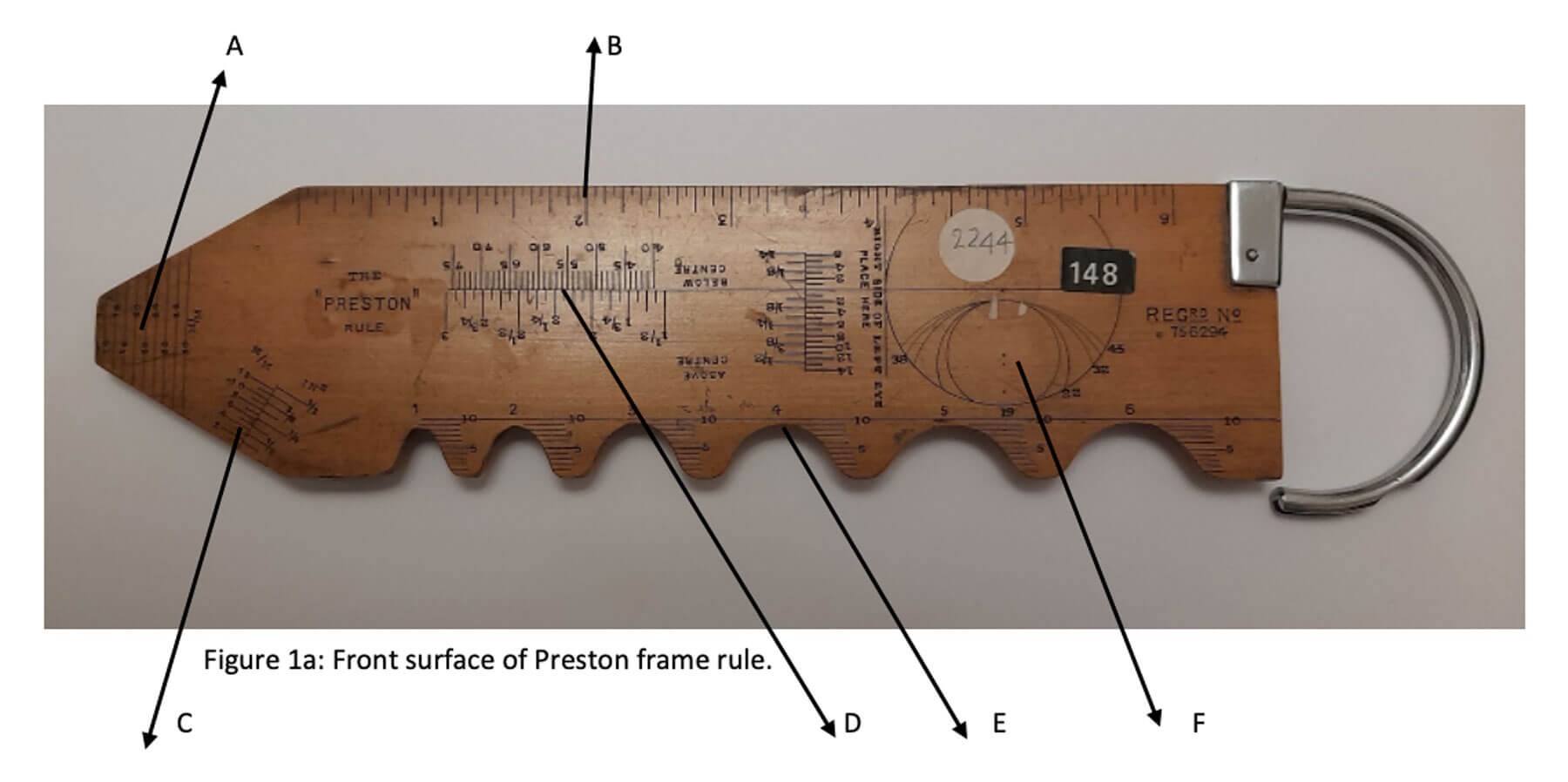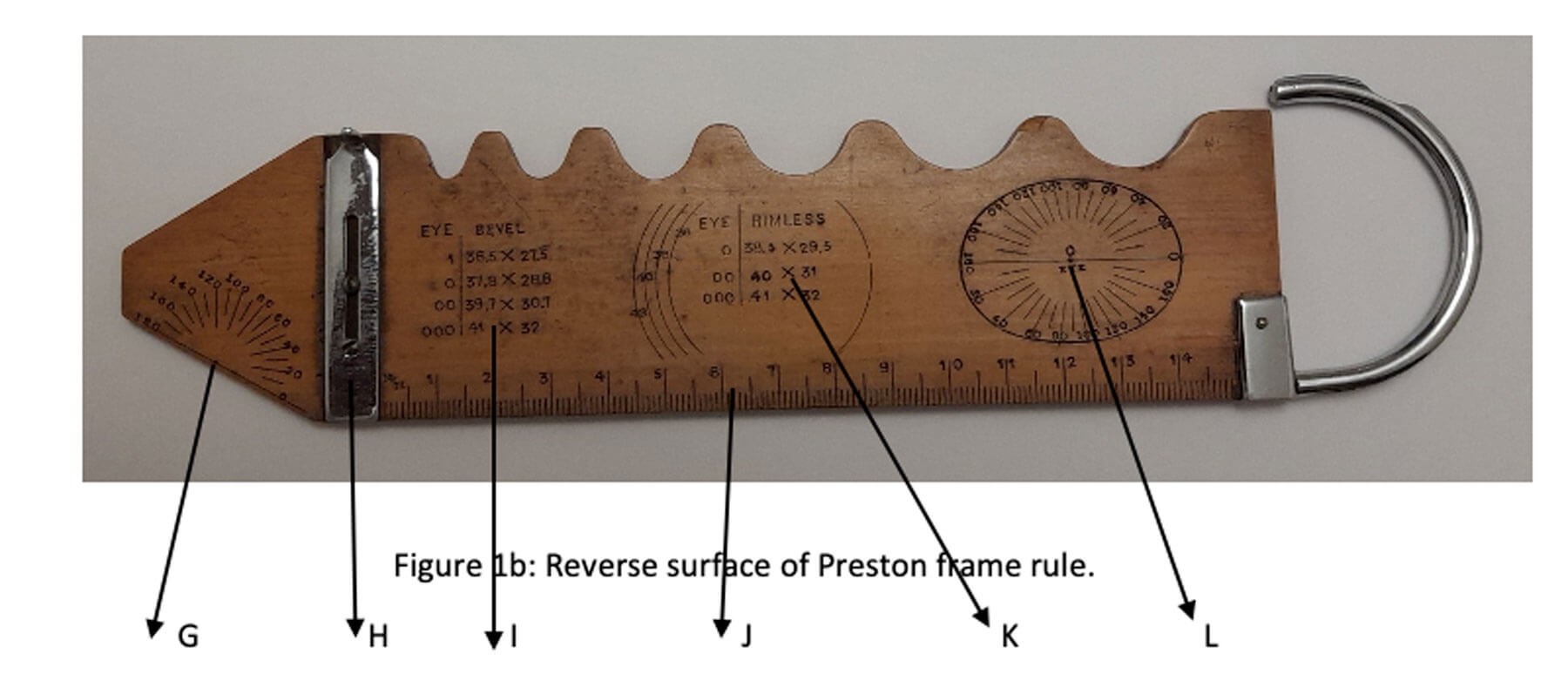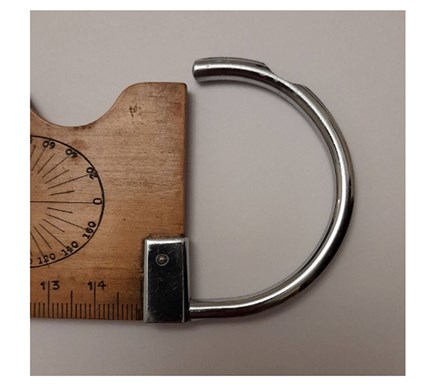
The selection, specification and fitting of a spectacle frame necessitates the recording of certain measurements particular to the frame. These measurements are also essential when it is required to manufacture a handmade spectacle frame. Instruments designed to accomplish this task are referred to as frame rules. Britain may fairly claim to have set several historic precedents in the measurement of frame parameters.
In 1903 the Standards Committee of the British Optical Society presented a report which for the first time included standards for spectacle frame measurements [1]. In 1928 the Institute of Ophthalmic Opticians together with the Association of Wholesale & Manufacturing Opticians published a report recommending the use of the Metric System for linear frame measurements [1]. In a landmark article in 1935, Cole & Blackburn introduced the datum line system of frame measurements. It was proposed that the datum line be positioned halfway between the horizontal and vertical tangents to the upper and lower edges of the spectacle lens shape [2]. Henceforth all frame measurements would be given with respect to the datum line. However, with the introduction of BS 3521 in 1991 the term datum line was replaced by the term horizontal centration line (HCL) [3].
Over the years, many and varied frame rules have been produced. Some have been little more than modified millimetre rules, designed to take only a limited number of measurements. Whilst others have been comprehensive measuring devices. Examples of the latter will usually have a prominent central horizontal line representing the datum line (HCL). Since facial characteristics and frame dimensions are intimately related, many frame rules could also be used to measure certain facial parameters. (For this purpose the rule has to be positioned in the assumed plane of the spectacle frame.)


Figures 1a and 1b show the front and reverse surfaces of a double sided rectangular frame rule manufactured not long after the datum system of measurement was introduced [4]. The instrument was acquired by the author many years ago from an optician who was retiring. Of robust and sturdy construction the rule is made from boxwood and has some metal adornments. Boldly printed on the front surface is the legend: ‘THE PRESTON RULE’ along with a registration number: 756294. These pieces of information proved invaluable in tracing the origins and history of this design of frame rule through the auspices of the British Optical Association Museum at the College of Optometrists [4].
The Preston Rule was manufactured and distributed by the British firm of Levers Optical Co. Ltd. This business was originally incorporated as a public company in 1934 as a manufacturer of spectacle frames and lenses, based in Mount Pleasant off the Grays Inn road in central London. The company continued to operate as an optical business until it was sold in 1980 [5]. The Registration Design number 756294 was issued in 1930 indicating the original date of manufacture for this frame rule [4].
A catalogue published by Levers Optical Co. in 1938 describes the instrument as a ‘useful pocket rule’ designed in conjunction with the late Mr AJ Preston DSc. The aforementioned gentleman was presumably an optical advisor to the company. The catalogue further states that the rule ‘embodies every useful feature and requirement essential to the refractionist either in the fitting room or optical work bench’ [4].Inspection of the numerous features on the rule demonstrates just how advanced frame and facial measurements had become in the first half of the twentieth century.
Both surfaces of the Preston Rule provided scales which enabled salient measurements to be taken on metal or plastics spectacle frames. N.B: scales are graduated in units of measurement that would have corresponded with the accuracy required or attainable at the time the rule was manufactured.
A brief summary of the important scales will now be presented. Figure 1a shows the front surface of the rule and the scales are lettered A to F.
Scale A: Horizontal lines of increasing width intended for measuring the distance between the pads on the bridge of a metal or plastics frame.
Scale B: a straightforward inch scale.
Scale C: small horizontal lines in one millimetre gradations; probably intended for measuring the bridge height of frames, or bifocal segment heights.
Scale D: a central horizontal line intended to represent the datum line (HCL) from which many frame measurements would be made. At right angles to the datum line are a series of horizontal lines separated by one millimetre gradations. These are for frame bridge heights to be measured. Curiously, scale D appears to be upside down compared to other scales on this surface of the rule! Scale D would have been particularly useful for measuring the datum centre distance of a spectacle frame (sometimes erroneously referred to as the frame PD). In practice, the DCD of a frame is measured from the inside of one rim to the corresponding point on the inside of the other rim. To help position the frame for taking this key measurement the rule has a ‘zero point’ on the datum line which states; ‘right side of left eye place here’.
Scale E: a series of cut out curves arranged along the entire length of one side of the rule. The purpose of the curves was to measure the apical radius of the spectacle wearer’s nose and the width of the nose (referred to as the base) at certain depths, thus allowing accurate design of the bridge of a frame. To assist in the base measurement a series of horizontal lines are engraved from the bottom edge of the rule upwards. A simple ruler laid across the cut out at the desired level indicates the base width.
Scale F: a series of round bifocal segment diameter sizes. Figure 1b shows the reverse surface of the rule and scales are lettered G to L.
Scale G: a small size protractor scale. As well as checking the axis of an astigmatic spectacle lens this scale could also have been used to measure the angle a frame side makes to the front of the frame.
Scale H: this is a metal ‘arm’ which can be extended vertically downwards to sit at right angles to scale J and would have facilitated the ‘alternate eye’ method of measuring a patient’s interpupillary distance [6].
Scale J: This is a straightforward millimetre rule. Its uses, however, would have been numerous. For example, measuring the patient’s head and temple width, along with the corresponding measurements on the spectacle frame. Other linear measurements would include frame side length and bifocal segment size and height.The purpose of scales I and K is something of a mystery. Their exact use has become obscure with the passage of time. Both scales refer to rimless eye sizes of increasing dimensions. It seems likely that the scales would have been used in optical workshops where an unmounted round or oval rimless lens would be placed directly onto the scale in preparation for cutting and edging.
Scale L: this is a large size protractor scale. Its size would make it particularly useful for checking and marking the axis position in uncut or mounted astigmatic spectacle lenses.

Figure 2: Metal curved component attached to the Preston Frame Rule.
One of the most striking features of the Preston Rule is the metal semi-circular curve attached to the right hand end of the instrument (Figure 2).

Figure 3: Example of curved-end spectacle side.
This metal component can freely rotate 360 degrees around its horizontal axis. Furthermore, it has a narrow indented groove carved into its outer surface. During the interwar years many spectacle frames were produced with so-called curl end sides [7] (Figure 3). The end of these sides would usually be flexible and designed to fit snugly around the groove behind the wearer’s ear. Measurements relating to this type of side could be undertaken by fitting the curl into the indented metal groove described above and using scale I (Figure 4).

Figure 4: Example of measuring the length of a curved-end spectacle side.
Today the measurement of frame and facial parameters is an everyday occurrence in establishments dispensing spectacles. Numerous rules are readily available to assist in this task. A glance through the catalogues of optical suppliers reveals the most popular to be the ABDO Rule, the City Rule and the Serelo Rule [8].
The Preston Rule was an early attempt to facilitate the selection, specification and final fitting of spectacle frames and rimless mounts and would have been used in optometry practices or optical workshops. It would also have been useful in the teaching of ophthalmic dispensing. It seems reasonable to suggest that the Preston Rule was one of the forerunners of today’s frame rules.
Perhaps the most remarkable aspect is that its design would render the instrument still usable today.
Acknowledgement
The author wishes to express his gratitude to Mr Neil Handley, Curator of the British Optical Association Museum at the College of Optometrists, London, and to Mr James W Broomhall, Optical Manufacturer, Glasgow for their assistance in the writing of this article.
References
1. Obstfeld H: Spectacle Frames and their Dispensing. WB Saunders & Co: London; 1997.
2. Cole J, Blackburn A. Frame Measurements by Datum Line. Optician 1935;89(2302):235-6.
3. BS 3521. Terms relating to Ophthalmic Optics and Spectacle Frames. Part 2. British Standards Institution, London, 1991.
4. Hadley N. Personal correspondence with the author, 2021.
5. Panther Securities PLC. 2021:
www.pantherplc.com
6. Fairbanks P. The Facial Measurement Gauge. Ophthalmic Optician 1968;8(3):114-6.
7. Sasieni LS: The Principles and Practice of Optical Dispensing and Fitting (Third Edition). Butterworths: London; 1975.
8. ABDO College bookshop:
https://abdocollege.org.uk/bookshop/
(All links last accessed June 2021).
COMMENTS ARE WELCOME





